In the SaaS world, churn rate is a crucial metric for gauging customer attrition over time. With its definitive impact on key performance indicators (KPIs), understanding and optimizing churn rates proves essential for business growth.
Churn rate is not simply about losing a customer but also about losing the recurring revenue they would generate for your business. It reveals gaps in retention strategies while casting light on potential areas for improvement.
Stay with us to get your questions such as “What is the average churn rate for a SaaS company?” and “What is a good churn rate for SaaS?” answered. Gain deeper insights into managing this vital cog, as you wheel your SaaS venture forward.
Understanding Churn Rate
The heart of any SaaS business rests heavily on its customer retention capabilities. Primarily, the churn rate measure calculates the proportion of contractual customers or subscribers who leave during a given period. It provides deep insights into both customer and revenue churn.
Understanding this vital metric allows SaaS companies to dig into specifics around dissatisfactions and hence formulate strategies to reduce this burning figure, shoring up customer lifetime value (CLV) and enhancing monthly recurring revenue (MRR) in the process.
In this regard, remember the following three essentials:
- A low churn rate could signify higher customer satisfaction levels while a lot of churn means more dissatisfied customers.
- More retained customers often result in positive word-of-mouth marketing.
- A decrease in churn instantly means more MRR without adding extra service costs for new customer acquisition.
Strategies such as upselling and providing personalized customer experiences improve churn rates over time, which we’ll discuss in further sections below. Stay tuned!
SaaS churn rate calculation
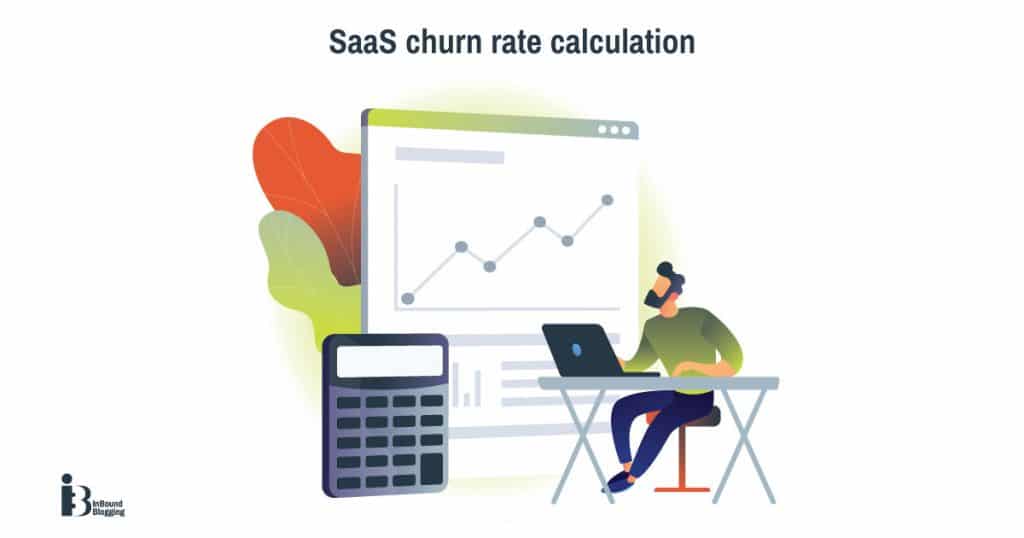
Churn refers to the number of customers or the amount of revenue that your company loses over a given period (expressed in percentage).
To calculate it, follow this basic SaaS churn rate formula:
Churn rate = [(Number of customers at start – Number of customers at end/Number of customers at start] x 100
Example: Consider a scenario where you have 1,000 customers at the beginning of the month, and by the month’s end, you have only 950 left, so:
Churn rate = [(1000-950)/1000] x 100 = 5%
This means that an alarming 5% of your customers “churned” or discontinued their service through either a voluntary departure or involuntary closure due to non-renewal or non-payment issues.
Voluntary and involuntary churn
Customer churn in SaaS can broadly be categorized into two types: voluntary and involuntary churn. Here is what you should know about them:
- Voluntary churn: This occurs when a customer consciously decides to stop using your service. The reasons for such churn can range from substandard product quality, a lack of customization, a non-intuitive user interface, competition, or simply not finding enough value. It’s crucial to analyze and understand this behavior early on, as it directly impacts your MRR and your overall business growth strategy.
- Involuntary churn: This kind of churn is mostly beyond a company’s control. Example reasons are failed payments, customers moving out of business, or legal issues. The analytics and trends from involuntary churn rates are different to voluntary churn as they are less reflective of product value.
Recognizing these two types adds depth to understanding your customer segmentation, their needs, and their grievances, thereby necessitating the need for architecting a data-driven proactive customer success initiative to reduce your churn rate.
Customer churn vs. revenue churn
Understanding churn involves discerning between two crucial aspects: customer churn and revenue churn. They each use different methods for calculating the churn rate in SaaS companies.
Let’s walk you through them.
Customer churn
This churn measures the number of customers who stop using your software over a specific time frame. It directly affects the count of active users and, in turn, impacts overall business stability and growth.
- Gross customer churn measures the percentage of customers lost over a specific period, calculated as:
Customer Churn = [(Number of customers at the start of the period – Number of customers at the end) / Number of customers at the start] x 100
Example: If you have 100 customers at the start of the month but only 90 at the end, you would have a SaaS customer churn rate of 10%.
- Net customer churn takes into consideration revenue expansion from existing customers, calculated using:
Net Customer Churn = [(Churned revenue – Expansion revenue) / Total revenue at the start] x 100
Example: Suppose a company has a total revenue of $100,000 at the start of the month. During the month, it loses $10,000 in revenue from customers who cancel their subscriptions or downgrade their plans. However, it also gains $5,000 in revenue from customers who upgrade their plans or buy additional services. The net customer churn for the month is:
Net Customer Churn = [($10,000 – $5,000) / $100,000] x 100
Net Customer Churn = 5%
This means that the company’s revenue decreased by 5% due to customer churn.
Revenue churn
Here, instead of measuring losses in terms of customer numbers, revenue churn calculates the dollars lost due to customer churn. It is crucial to understand the economic implications—directly affecting monthly recurring revenue (MRR) or annual recurring revenue (ARR).
Both gross revenue churn and net revenue churn assess SaaS companies’ revenue retention. Gross revenue churn is calculated by:
Gross Revenue Churn = [(Revenue at start of the period – Revenue at the end) / Revenue at the start] x 100
Example: Let’s say that $5,000 was your monthly revenue at the beginning but simmered down to $4,500 by month-end due to churn; thus, you have 10% gross revenue churn.
Meanwhile, net revenue churn considers further revenues from existing customers:
Net Revenue Churn = [(Churned MRR – Expansion MRR) / MRR at the start] x 100
Example: A company has 100 customers who pay $100 per month each at the start of January. That means its MRR at the start is $10,000. During January, 10 customers canceled their subscriptions, resulting in a churned MRR of $1,000. However, 20 customers upgraded to a higher plan and paid $150 per month each, resulting in an expansion MRR of $1,000.
The net revenue churn for January is as follows:
[(1,000 – 1,000) / 10,000] x 100 = 0%.
This means the company did not lose any net revenue from its existing customers in January.
In essence, while gross churn indicates a loss in customers or earnings within a stipulated period, net churn includes growth proceeds from existing clients. It provides a comprehensive view of a business’s level of health.
What is negative churn?
Negative churn refers to the condition where established SaaS companies see a net revenue expansion from their existing customer base. Essentially, the profit from upselling, cross-selling, or increasing pricing exceeds lost revenue from churned customers. It can involve scenarios such as an increase in customers’ add-on purchases, upgrades to pricier plans, and more.
Negative churn implies that even if your company did not acquire any new customers (and presumably kept costs down), you would still see growth in your revenue. It’s an indicator of strong customer loyalty and high product value.
While boosting the average revenue per user and managing churn numbers are essential business objectives, negative churn should always be aimed at as it signifies truly sustainable growth.
Analysis of churn rate trends and patterns over time
Analyzing churn rate trends over time aids in understanding customer retention patterns. The primary metrics evaluated are annual churn rate, monthly churn rate, and average churn rate. It’s important to keep in mind that the average churn rate by industry varies. So we’ll talk about SaaS specifically:
- SaaS annual churn rate: Indicates the yearly loss of customers or revenue.
- SaaS monthly churn rate: Highlights short-term, monthly changes, useful for evaluating immediate initiatives.
- SaaS average churn rate: Provides an overview of general customer retention performance.
These insights can guide proactive initiatives to reduce churn and enhance business growth for SaaS companies.
Factors Affecting Churn Rate
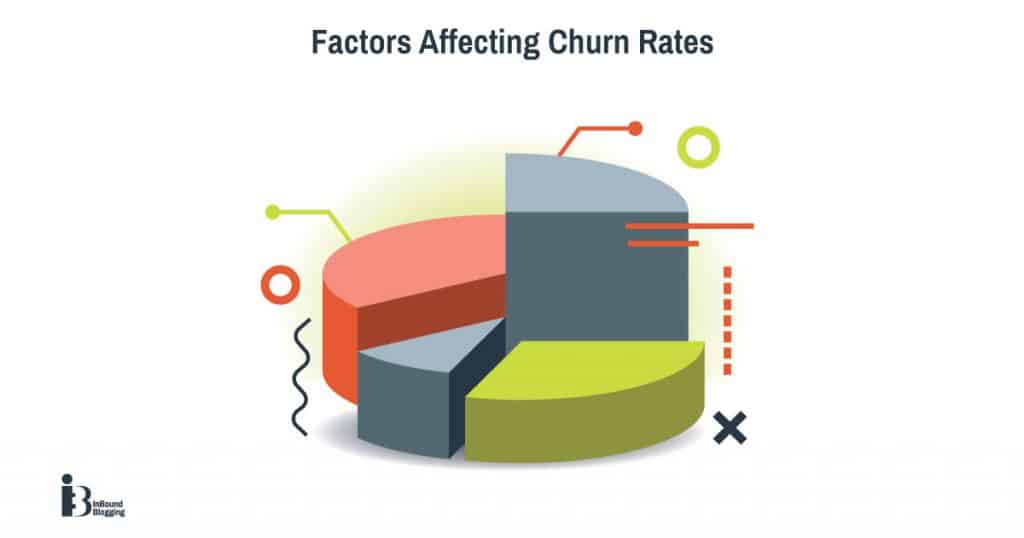
High churn rates can significantly curb a SaaS company’s growth. Understanding the factors affecting churn rate is crucial for formulating effective customer retention strategies.
Check them out below.
Customer satisfaction and support quality
Customers who receive high-quality support are often happier and more engaged. This results in higher customer satisfaction levels, leading to lower churn rates. To ensure your customer support is top-notch, focus on fast response times, empathetic communication, and effective issue resolution.
Moreover, personalizing experiences based on customer preferences can also significantly boost their perception of your brand’s value proposition. Regularly implementing feedback surveys can offer valuable insights into how you can improve customer satisfaction levels further.
Product/market fit and churn rate
Understanding your product and market fit and navigating the competitive landscape are critical to managing the churn rate. An unfit product or an undeveloped market increases customer dissatisfaction, leading to higher churn rates. Customers have plenty of alternatives; thus, if their needs are not met, they switch services, impacting your revenue churn rate.
Customer segmentation
Understanding churn behavior in SaaS companies heavily relies on effective customer segmentation. It helps in evaluating specific groups demonstrating high churn rates. Segments can be based on product usage, customer satisfaction levels, or preferred features. Leveraging data analytics helps draw vital insights from these segments. Focusing attention on problematic segments is key to reducing both customer and revenue churn.
Setting Churn Rate Goals
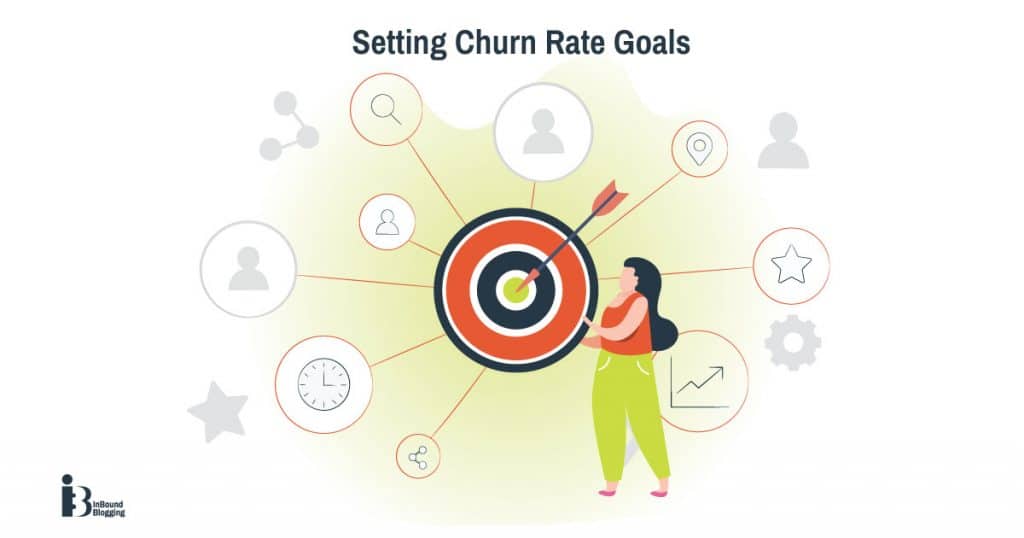
In this section, we discuss setting churn rate goals for SaaS companies, considering factors such as the business’s growth strategy, industry averages, and the importance of understanding both your customer acquisition cost (CAC) and customer lifetime value (CLV). We also explore the usefulness of incorporating customer feedback, etc.
Aligning churn rate goals with overall business objectives
Establishing churn rate goals is vital to forming strategies that help reduce churn. Your purpose should be to align these targets with your overall business objectives and growth strategy. Essentially, it looks at balancing customer acquisition cost (CAC) and customer lifetime value (CLV) while trying to maintain a low churn rate.
Setting offshore targets isn’t beneficial; instead, they should resonate with the broader vision of your company. Start by understanding your industry average, i.e. the average churn rate for SaaS companies. Then, stage-specific benchmarks related to metrics such as MRR and CAC.
When setting goals, consider factors such as the product/market fit, the competitive landscape, and the personalized customer experiences you offer.
The importance of SaaS churn benchmarks to overcome competition
Being familiar with SaaS churn rate benchmarks is pivotal for any SaaS company.
Here is why:
- It provides a relevant context for your company’s performance.
- It helps identify business growth opportunities.
- It highlights discrepancies between your churn rate and the industry average.
A higher discrepancy indicates further room for improvement. It’s important to understand the average churn rate for your field, so you’ll know what number to target.
What is the average SaaS churn rate?
It depends on factors like company age, size, and growth pace. However, the average monthly churn rate for SaaS companies is around 3% to 8% monthly. The average annual churn rate for SaaS is usually between 32% and 50%.
The next logical question is “What is a good SaaS churn rate?” It should be lower than the typical churn rate for SaaS, or less than 3%. The average B2B SaaS churn rate for a year is 4.67%, which is slightly lower than the average B2C SaaS churn rate (5.06%)
Reliable mechanisms such as data analytics and customer segmentation can help to get your numbers close to the average churn rate in SaaS. Make sure to continually optimize your strategies for better SaaS growth prospects.
Considering customer lifetime value (CLV) and customer acquisition cost (CAC)
Considering customer lifetime value (CLV) and customer acquisition cost (CAC) is crucial when setting goals. The difference between the two denotes profitability, with a higher CLV-to-CAC ratio suggesting more returns per customer.
- Improve CLV by enhancing customer experiences and retention
- Lower CAC by optimizing marketing efficiency
A balance of these two metrics significantly drives down the churn rate, promoting sustainable business growth in the competitive SaaS industry.
Incorporating customer feedback and sentiment analysis
Incorporating customer feedback and sentiment analysis provides invaluable insights to understand customer behavior, experiences, and satisfaction levels.
You can gather feedback through surveys, user testing sessions, or review data. Use sentiment analysis tools to gauge positive and negative impressions of your SaaS product or service.
This information allows you to set realistic goals regarding churn reduction, tailored toward improving specific aspects identified by the customers themselves. These might include product functionalities, support quality, or pricing issues.
Strategies for Reducing Churn Rate
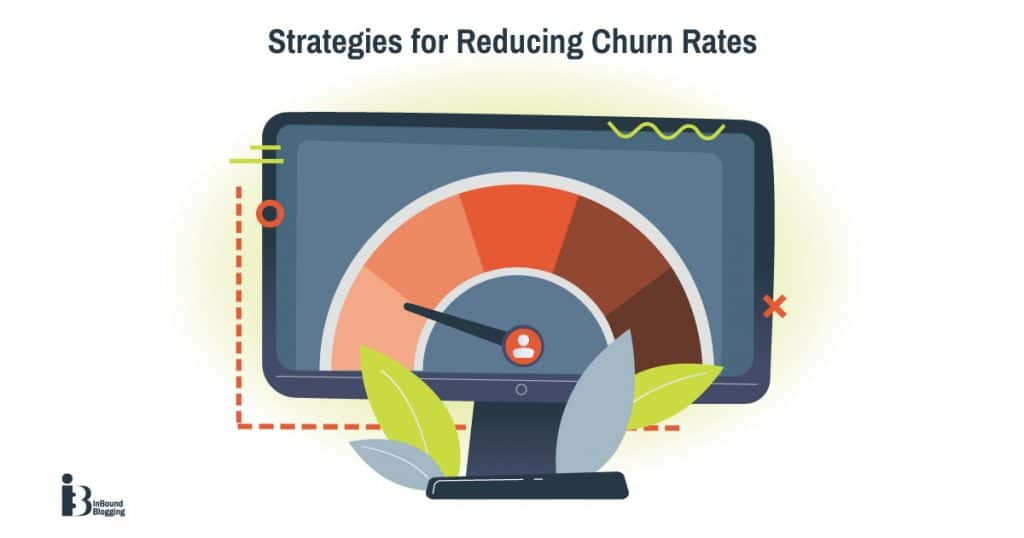
In the competitive landscape of SaaS companies, reducing the churn rate is a core strategy for business development. The effectiveness of this process can be enhanced by implementing several approaches that include:
Personalizing customer experiences to improve satisfaction and retention
This is a potent approach to boosting satisfaction and, in turn, reducing the churn rate.
Implementing proactive customer success initiatives plays a crucial role in identifying and mitigating potential churn risks. This starts with understanding and segmenting your customers to identify their specific needs. Then, it extends to offering personalized service and regular check-ins for higher satisfaction and retention levels.
Key steps include:
- Understanding customer behavior: Use data analytics to evaluate user behavior and patterns.
- Regular check-ins: Ensure routine communication with clients.
- Address issues early: Identify problems before they affect the customer experience.
Proactivity not only demonstrates value but can turn a possibly negative situation into a positive experience, thereby reducing the churn rate.
By tailoring interfaces, features, customer support interactions, and communication for individual customers, companies can significantly enhance their user experience.
| Personalization type | Description |
| UI personalization | Enhance user engagement with tailored interfaces |
| Feature personalization | Customize functionalities based on user behavior |
| Communication personalization | Send individualized messages based on usage patterns |
| Support interactions | Offer assistance centered around the unique issues of each customer |
Embracing personalization can lead to higher satisfaction levels among customers, leading to improved retention rates.
Utilizing data analytics to identify early warning signs of churn and take proactive measures
Data analytics plays a significant role in predicting the churn rate. It helps identify early warning signs, allowing SaaS companies to take proactive measures.
Analytical approaches include:
- Behavioral pattern analysis: Customers showing decreased product usage or engagement are likely to churn.
- Sentiment analysis: Customer reviews, SaaS survey responses, and feedback help recognize negative sentiments indicative of potential churn.
By identifying patterns using data analytics, you can pre-empt drop-offs and implement strategies for customer retention, such as offering personalized customer experiences, improving onboarding processes, or taking advantage of upselling opportunities to encourage continued association with your platform.
Optimizing the onboarding process to ensure a smooth and successful customer journey
The customer onboarding process is a key component in the fight against a high churn rate. A seamless and personalized onboarding experience can lead to improved customer satisfaction and thereby minimize involuntary churn.
Key steps include:
- Personalizing experiences: Customization builds engagement, facilitating retention.
- Improving product/market fit: Conducting informative demos of the product, etc.
- Providing comprehensive support: High-quality customer support reduces issues during the onboarding phase.
Strategically optimizing the onboarding process not only reduces churn but also decreases the overall customer acquisition cost while increasing customer lifetime value.
Leveraging upselling and cross-selling opportunities to increase customer value and retention
Upselling involves enticing customers to purchase more expensive items, upgrades, or add-ons, while cross-selling encourages the purchase of related products.
- Upselling: Offering enhanced features or premium versions can directly boost customer value and satisfaction.
- Cross-selling: Recommending supplementary products or services not only increases revenue but also deepens the customer’s engagement with your brand.
By strategically utilizing these tactics, SaaS companies can effectively reduce their churn rate.
Addressing pricing issues and competitor offers to retain customers
Addressing pricing issues promptly and effectively can significantly improve retention. Comparisons with competitor offers should be done frequently to ensure your product/market fit is superior.
Here are some methods to address this issue:
- Benchmarking churn rate: Regularly compare your rates against industry averages.
- Implement differential pricing: Provide value by tailoring prices according to varying customer segments.
- Leveraging upselling and cross-selling opportunities: As mentioned above, these strategies not only increase CLV but also satisfy diverse client needs, creating additional barriers for customers to exit.
Understanding one’s place in the market and using such strategies can ultimately reduce the churn rate and positively affect revenue.
Key Metrics for Tracking and Managing Churn Rate
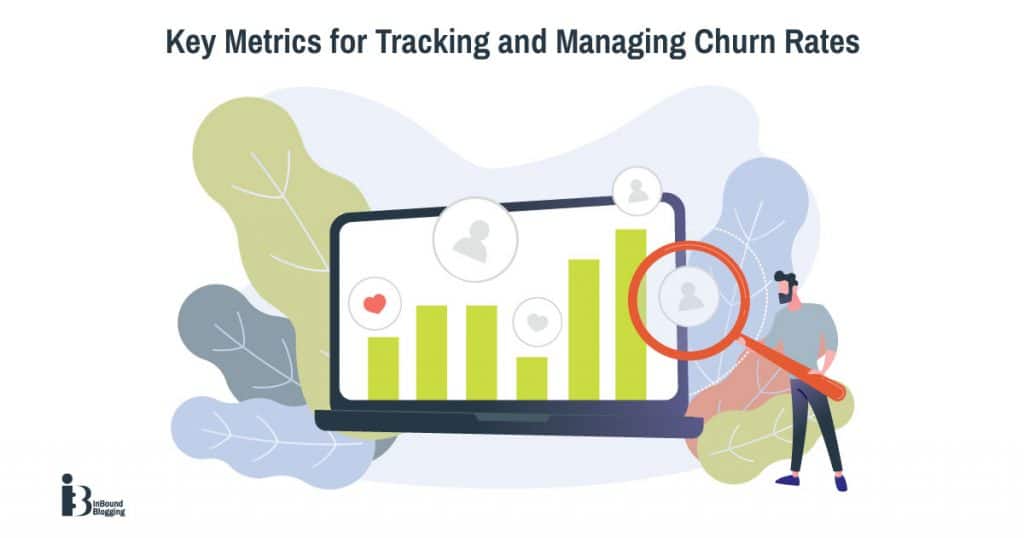
To optimize your churn rate, you need to analyze other SaaS metrics as well, such as monthly recurring revenue (MRR), annual recurring revenue (ARR), customer acquisition cost (CAC), and customer lifetime value (CLV).
Additionally, assessing customer sentiment through the net promoter score (NPS) and conducting lead velocity rate (LVR) calculations are essential to understanding and predicting churn behavior.
Monthly recurring revenue (MRR) and annual recurring revenue (ARR)
Monthly recurring revenue (MRR) and annual recurring revenue (ARR) are significant metrics for determining the financial status of SaaS companies.
MRR is determined by multiplying the total number of customers by the average earned revenue per customer per month. This metric provides insights into monthly earnings, helping businesses predict their financial future. ARR, on the other hand, projects the company’s recurring revenue over a year. Including these metrics in the churn rate calculation offers a more realistic view of a business’s financial health status.
Customer acquisition cost (CAC) and customer lifetime value (CLV)
Customer acquisition cost (CAC) and customer lifetime value (CLV) are critical financial metrics for SaaS companies, especially when analyzing churn rates.
- CAC is the total cost of acquiring a new customer, including all aspects of marketing and sales. A high CAC can indicate problems with your marketing efficiency or product/market fit.
- CLV indicates the total revenue a company can expect from a single customer over its lifetime. Tools like data analytics can help project this value.
Tracking the ratio between these two values, i.e., the CLV:CAC ratio, provides insights into one’s overall business growth strategy and influences decision-making for customer retention. A good CLV:CAC ratio is typically above 3:1.
Net promoter score (NPS) and customer satisfaction metrics
The net promoter score (NPS) is a crucial metric for measuring customer satisfaction and loyalty. Calculated based on responses to the query “On a scale of 0–10, how likely are you to recommend our company or product?”, it segments customers into detractors, passives, and promoters.
| Customer group | Score range |
| Detractors | 0-6 |
| Passives | 7-8 |
| Promoters | 9-10 |
A high NPS implies strong customer loyalty; hence a lower churn rate in your SaaS company.
Another key tool is customer satisfaction metrics, gauged via feedback surveys like CSAT, which reveal immediate issues affecting client experiences or causing churn. Use these alongside data analytics for a comprehensive understanding of churn.
Lead velocity rate (LVR) and forward-looking churn indicators
The lead velocity rate (LVR) is a forward-looking churn indicator vital for SaaS companies. It measures month-over-month growth in qualified leads, predicting future revenue and churn rates. An increase in LVR indicates business growth and potentially lower churn rates.
Forward-looking churn indicators include:
- Increasing customer acquisition cost (CAC)
- Decreasing customer lifetime value (CLV)
- Negative customer feedback or a low net promoter score (NPS)
Monitoring these metrics alongside LVR provides an early warning system to identify potential risks of increasing churn.
Measuring and Tracking Churn Rate

Focus on implementing a robust data tracking system, utilizing customer feedback surveys and sentiment analysis, and incorporating predictive analytics as well as machine learning approaches to accurately track your churn.
Implementing robust data tracking and reporting systems
This includes setting up systems that provide comprehensive dashboards that accurately track pivotal metrics, such as customer acquisition cost (CAC) and customer lifetime value (CLV). Additionally, these systems trace churn trends over time.
Offering real-time access to this essential data supports informed decision-making, thereby mitigating involuntary churn rates and promoting sustainable business growth. Key measurements include but are not limited to CAC, CLV, and recurring revenues, both monthly (MRR) and annually (ARR).
Utilizing customer feedback surveys and sentiment analysis
SaaS companies often utilize customer feedback surveys to understand their experiences, preferences, and pain points. This invaluable data reveals insights into product/market fit, highlights areas for improvement, and aids proactive customer success initiatives.
Additionally, employing sentiment analysis brings an extra layer of understanding customer sentiment hidden in their written or spoken communications. Leveraging these techniques together ensures a comprehensive understanding of the factors affecting churn rate, thus paving the way to tailored strategies and solutions for reducing it.
Incorporating predictive analytics and machine learning to forecast churn rate
Predictive analytics use historical data to identify patterns and trends, while machine learning algorithms can recognize potentially complex patterns in customer behavior. In short, here is what you should know about them:
- Predictive analytics: Apply to identify indicators of churn, such as sudden decreases in usage or negative feedback.
- Machine learning: Use pattern recognition across your SaaS company’s big data sets to predict customer decisions better.
Case Studies and Examples
Here, we examine specific SaaS companies and how they’ve successfully reduced their churn rate. Read on.
Real-world examples of successful SaaS churn rate reduction strategies
SaaS churn reduction is possible through various strategies. Here are five experts who share their advice and experience with reducing churn:
- Have a clear onboarding process
“One of the most effective strategies for reducing churn rates in SaaS companies is to have a clear and well-defined onboarding process. This should include easy sign-up steps, tutorials, and other educational materials that help customers get familiar with the product quickly.
Additionally, providing timely customer service and support is also essential to keep customers loyal. Creating personalized content, such as newsletters, emails, or other communication tailored to the customer’s interests and needs, can also be a great way to keep customers engaged and reduce the churn rate.”
Tristan Harris, Demand Generation Senior Marketing Manager, Thrive Agency
- Include scalable solutions
“I’ve found that offering a flexible and scalable product is key. Customers’ needs change as they grow; and if our product can’t grow with them, they’ll churn. By providing scalable solutions and pricing tiers that accommodate growth, we encourage customers to stay, evolve, and expand with us. This flexibility, coupled with a robust product roadmap that anticipates future customer needs has been crucial in improving our customer lifetime value and minimizing attrition.” Michael Chen, Head of Growth, Notta
- Offer account hibernation option
“Most SaaS companies offer customers two options: stay subscribed and keep paying, or cancel your service—a pretty simple dichotomy. However, one strategy that I’ve recently seen is offering a third option: hibernating your account.
Rather than allowing a customer to cancel and likely never see them again, these companies offer customers the option to hibernate, or essentially pause, their account for 60 or 90 days with no charge. The appeal of this to customers is that the company will save their work for the period of hibernation, as compared to that work being deleted seven days after cancellation.
This leverage worked on me when I recently canceled a SaaS service. Rather than cancel, I opted to hibernate my account for 90 days in case I changed my mind and came back. It doesn’t cost me money either way, and my work is still there if I re-up. I don’t have the data, but I have to imagine this third option of hibernation reduces overall attrition and increases customer lifetime value.” John Ross, CEO, Test Prep Insight
- Use predictive analytics
“I’ve leveraged predictive analytics to identify at-risk customers before they even consider leaving. By analyzing usage patterns, support ticket history, and customer engagement, I can predict which customers might face issues or not see the full value of our product. My team can then proactively reach out with personalized solutions or training, often preventing churn before it’s even a risk.” Eric Lam, Founder, Exploding Ideas
- Broaden payment acceptance
“Expand payment acceptance. Different kinds of payment are common in different areas. The easier it is for people to pay for SaaS, the more likely they will be to continue using the service. Offer payment options in local currencies. Adjust prices based on local rates. Most US-based companies accept only Visa and Mastercard. Accept a wider range of payment networks. Set up options for automated payments. Broaden your accepted payment methods, like including digital wallets. Making it easier to pay will make your service more accessible, and you can expect your churn rate to decrease by up to 25%. Customers will also feel more satisfied and have a better relationship when they do not need to struggle to make payments each month. James Owen, Co-Founder and Director, Click Intelligence
Analysis of specific companies and their initiatives to drive churn reduction
We present to you two big players in the SaaS market and how they managed to reduce customer churn. Learn how they did it:
- Mention, an online tracking service for businesses, effectively reduced churn by 22% through a strategic communication plan with their customers. The approach involved prioritizing support requests from valuable users, simplifying support ticket assignments, leveraging automated marketing emails to encourage feature activation, and conducting webinars. This plan significantly reduced the time spent on support and increased user satisfaction, making the service more valuable to customers.
- Software developer Patrick McKenzie reveals that around 40–60% of users sign up but never return to most software or SaaS platforms. With his Bingo Card Creator, he observed a user drop-off during the onboarding process stages. However, upon introducing a progress indicator and options for speeding through default settings, user completion rates rose to almost 90%, which made users less likely to churn. The improved results emphasize the importance of having an intuitive onboarding process and clear communication with users for better engagement and retention.
Conclusion
Churn rate management is an ongoing aspect of a SaaS company’s growth strategy. We’ve highlighted the importance of understanding and reducing the churn rate, keeping focus on metrics such as CLV and CAC, leveraging the power of data analytics, and personalizing customer experiences.
There are different averages in churn across industries. The typical SaaS churn rate is anything between 3% and 8%. Generally, a churn lower than 3% is considered a good rate for SaaS. One thing is certain: companies must continuously strive for improvement and prioritize churn prevention and reduction. Embrace this challenge head-on to turn potential losses into lasting gains.



